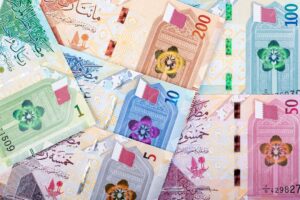The Qatari riyal is the official currency of the State of Qatar, which is situated on the Arabian Peninsula. Its currency code is QAR. One hundred dirhams make up one Qatari riyal. The money is referred to by the English acronym QR. Another common name for the rial is rial.
The Qatar Central Bank, whose goals include monetary stability and regulatory management of the currency, issuing all notes and coins for Qatar.
Getting to know the Qatari Riyal (QAR)
When Dubai joined the United Arab Emirates (UAE) in 1973, the Qatari riyal replaced the Qatar and Dubai riyals. At this point, Qatar started issuing the riyal on its own. The Indian rupee, the former currency, was replaced in 1966 when the Qatar and Dubai riyal entered into force as a result of India’s depreciation of its currency.
The exchange rate between the riyal and the U.S. dollar (USD) is 3.64 QAR to 1 USD, or USD/QAR = 3.64. The peg gained legal status after being codified into law by royal decree in 2001. The currency shall be kept within a range of 3.6385 and 3.6415 riyals per USD by the law.
The peg of Qatar’s currency lessens possible economic shocks because the country’s economy is primarily dependent on commodities like oil and natural gas, whose prices are expressed in U.S. dollars. The vast majority of Qatar’s GDP is comprised of the oil and gas sector.
One, five, ten, fifty, one hundred, and five hundred riyal bills are available in the Qatari riyal. One, five, 10, 25, and 50 dirham coins are available.
Economy
- The industry of petroleum and natural gas, which was founded in 1940, is the foundation of the economy. About 85% of exports and half of the GDP are made up of oil and gas.
- The recent high levels of economic growth in Qatar are a result of the high oil prices. Due to the high price of oil, Qatar has the second-highest GDP per capita in the world.
- Qatar enjoys a profit as a percentage of GDP that is among the greatest in the entire globe thanks to oil.
- Since Qatar has no income tax, its citizens are among the least taxed and richest in the world.
- The Qatari government is trying to diversify its economy to lessen its reliance on oil and gas. To entice foreign private investments and businesspeople, the nation has implemented new advancements, tax incentives, and capital expenditures.
Coins
In 1966, the first Qatari and Dubai riyal coins were released. Bronze 1 and 10 and cupronickel 25 and 50 dirham coins made up the series. On the back of each, a Goitered Gazelle (Gazelle subgutturosa) may be seen, along with the phrase “QATAR AND DUBAI”. The sheikhdoms of Ajman, Fujairah, Ras al-Khaimah, Sharjah, and Umm al-Quwain each produced commemorative coins with riyal values in 1969 and 1970.
The identical denominational coins from the first series were used in a new series of Qatari coins that were issued in 1973. In place of the Goitered Gazelle and “QATAR AND DUBAI” from the first series, “STATE OF QATAR” was used instead. Another series debuted between 2006 and 2008. The 1-dirham coin’s composition was changed to copper-plated silver, and the coin designs were slightly modified.
A commemorative series of 100-, 200-, and 500-riyal coins was released in 1998 to honor the Qatar Central Bank’s 25th anniversary. To honor the 15th Asian Games, coins with denominations of 1, 10, 100, 300, and 10,000 riyals were released in 2006. Commemorative coins for Qatar have also been issued in denominations of 250, 1000, 2000, and 5000 riyals.
Banknotes
The Qatar and Dubai Currency Board introduced notes with the riyal values of 1, 5, 10, 25, 50, and 100 on September 18, 1966. These notes were abandoned in 1973 in favor of ones printed by the Qatar Monetary Agency in the amounts of 1, 5, 10, 50, 100, and 500 riyal. When the Qatar Monetary Agency stopped issuing banknotes in 1996, the Qatar Central Bank continued the practice but used various designs for the same-denomination notes.
Currency Volatility
After certain foreign nations stopped doing business with Qatari banks in 2017, the value of the riyal changed in the offshore market, driving the value of the riyal to 3.81 in various foreign markets.
The official peg rate of 3.64 per dollar per Qatari dinar per year persisted during and after this period. This period, known as the diplomatic crisis, was brought on by several nations breaking diplomatic ties with Qatar and forbidding it from using their airspace or shipping lanes because it was thought that Qatar was funding terrorists.
A “solidarity and stability” pact was signed in January 2021 by Saudi Arabia, Egypt, the United Arab Emirates (UAE), and Bahrain to repair the diplomatic gap (commercial relations and a land, sea, and air blockade against Qatar).
Currency Exchange
One USD is equivalent to 3.64 QAR while traveling to Qatar. Unfortunately, a tourist who desires QR cash won’t acquire it at the live exchange rate. Typically, banks and currency exchange businesses will add a 3% to 5% service fee to the exchange rate they provide a customer. Therefore, the tourist will probably receive 3.46 QR, or roughly 5% less, for every USD, as opposed to earning QR3.64 QR.
The difference between the two rates is how the currency exchange makes its money.
By converting $1,000 at this rate, the traveler would receive QR3,460. Though not all of it, they do spend some of it on their vacation. They wish to exchange the remaining QR1,500 for USD when they return to the United States.
Please read: REAL EFFECTIVE EXCHANGE RATE (REER)
Conclusion
The official currency of Qatar, a fast-developing and prosperous country, is the Qatari Riyal (QAR), which has significant economic and financial significance. Due to Qatar’s considerable natural gas and oil reserves, which make it a significant player in the world energy markets, transactions involving these resources are frequently made in QAR. In addition, the nation’s robust economy, advantageous Middle Eastern position, and fiscal policies entice foreign investment, which raises the demand for QAR as a medium of exchange.
Therefore, for companies and investors interacting with the Qatari market or the country’s globally significant industries, understanding the exchange rate movements, impact on global commerce, and investment potential of the Qatari Riyal is essential.





